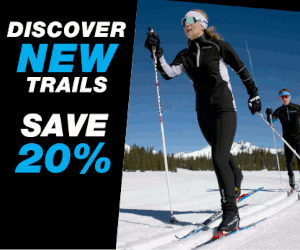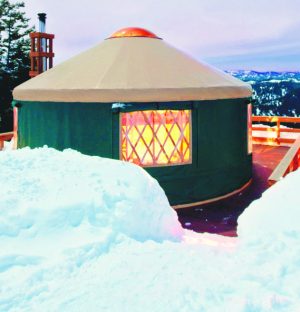January 11, 2016 (Salt Lake City, UT) – The ringing in of 2016 brings significant change in the Nordic world – namely a big step toward a universal boot and binding system. On Jan. 6 at Jeremy Ranch Nordic Center in Utah, Salomon debuted their 2016-17 lineup, which most notably includes the launch of their exciting new Prolink boot/binding system in parallel to their legendary SNS system. The new Prolink system makes Salomon compatible with NNN for the first time.
![SNS sole (left) compared to the new Prolink sole (right). Starting in 2016, Salmon boots are offered in either sole option [P] Katy Demong](http://skitrax.com/wp-content/uploads/2016/01/SNS-Prolink-boot-soles_Jan-06-10-31-12-AM-copy.jpg)
The concept of bridging the gulf between the two main binding systems in the Nordic ski world is a pretty big deal to insiders. While the Alpine world has offered one binding system for any boot for many years, the world of Nordic skiers has two products with the Salomon Nordic System (SNS) vs New Nordic Norm (NNN), creating debate and confusion at times among experienced and novice skiers alike.
With Salomon and Atomic, both owned by Amer Sports, on one side, and most other major brands led by Fischer (with SNS until 2007), Rossignol, Madshus, and Alpina on the other using Rottefella’s NNN, it’s the consumer that can sometimes be challenged to understand and choose. Salomon hopes to kick start a new era for the sport with Prolink.
“Before you talk about fit, before you talk about technology, before you talk about anything, the current question you ask a consumer, is ‘What system are you on,’” explained Isaac Wilson, Salomon Nordic Commercial Manager. “We’d like to change that conversation going forward to purely what is the best fit for you and what technology are you looking for.”
While some skiers sit squarely in one camp or the other, many novices can easily get confused. The incompatibility of the two systems is often seen as a hurdle for beginners entering the sport. In addition to the difficulty of learning to slide around on skinny skis, there’s also a steep learning curve of knowing what equipment to buy, what boots fit with what binding, and all the insider lingo that goes with it.
Can’t We All Just Get Along?
As mentioned, the Alpine community has long benefited from a standardized binding system. Unless you’re a tele skier or have a Randoneé setup, generally speaking any boot can work with any binding. While that’s an oversimplified explanation the takeaway remains true: if you buy a pair of alpine skis at a garage sale and a pair of boots on ebay, they’re probably going to work together.
The same can’t be said with Nordic equipment as it currently stands. While the new Prolink system won’t bring instantaneous universality to the Nordic world, it’s a significant step in that direction. Starting this year, Salomon will make their full gamut of boots available, from the Escape touring boot to the S-Lab Pro, with the option of either an SNS sole or the new Prolink sole. Now, tried and true users of the NNN system will be able to include Salomon in their equipment options.
A New Era
“This is such an exciting time,” Wilson said to the room full of retailers and other Nordic enthusiasts at Jeremy Ranch. “It feels like the moment when we’re all going to look back years from now and say ‘What did we do before? Why didn’t we do this earlier?’”
While Salomon could have created an NNN-compatible binding system before now, as patents on the competing system expired several years ago, Wilson said he’s excited they are doing it now. “We understand that we’ve only been speaking to a portion of the market when launching a new product and we’d like to create new opportunities,” he continued, noting that Salomon, once the dominant market leader, currently has around 30% of the market share in areas such as the east coast or some western states.
While Salomon and Atomic have retained as much as 70-80% market share in some areas, such as the midwest, they’ve seen movement in other sectors of the market to NNN’s NIS system which was launched in 2005. The split in the market became more apparent when Fischer, the leader for Nordic skis, made the switch to NNN in 2007.
Wilson is excited about the opportunities that lie ahead. “This is an exciting turnaround point. Prolink is the platform that will hopefully open things up for us,” he added. While Salomon has invested a tremendous amount of money into bringing high end products to the market like the S-Lab and S-Lab Pro lines, they recognize that there’s a big portion of the market that’s not being reached and they believe Prolink can spark a change in this regard.
More Control vs More Snow Feel
Even though Salomon has created an NNN-compatible system, Wilson is careful to point out that they haven’t simply replicated it. “Low, light, and powerful” is how he describes their Prolink system, serving as both a description of the binding and to point to contrasts with the competition.
![Here you can see the significantly lower profile of the Prolink boot in the same model [P] Katy Demong](http://skitrax.com/wp-content/uploads/2016/01/Prolink-boot-2_Jan-06-11-27-58-AM-copy.jpg)
The Prolink binding continues the direct mounting tradition of SNS and will also share the same drill pattern. Additionally, all skis will come pre-mounted, based on the camber of the ski, making life a little easier for retailers. The addition of the Prolink binding and the shift to pre-mounted skis moves Salomon toward a “no mistake system” for retailers, said Wilson. Another noteworthy change is that, in order to accommodate the single point of contact of the Prolink system, Salomon developed a slightly stiffer boot, which will now be standard across the board in both sole options.
Salomon will continue to produce and support the SNS two-bar system for the foreseeable future. Fans tout the added control and quick ski return they get from the additional point of contact, as well as a greater sense of stability, particularly on downhills and tight corners. Salomon has enjoyed a core group of loyal followers for this very reason and expects SNS products to remain popular. Asked about their future direction, Wilson said it will depend on what the market demands.
Putting it to the Test
It was time to test and there were plenty of skis and boots for all to try with Prolink or SNS systems to compare. I started out with a pair of S-Lab Carbon Skate Skis and S-Lab Pro boots – one pair for each binding system. The additional stiffness of the boots was evident, particularly in the toe box, a bonus for skate boots in my opinion. I stood a good half-inch or so taller in the SNS boot and the sole is significantly stiffer than the Prolink version of the same model.
I snapped into my SNS system on the left foot and then paused, looking for a comparable lever to open the Prolink binding. The Prolink binding has a rubber tab that you pull upward to open the binding and once you get the hang of it you’re all set. A more robust tab would be my preference and now it was time to hit the snow.
I quickly experienced some nuanced differences on the hard-packed, slightly icy conditions. Heading straight down a steep hill, the tightness of the boot-to-ski interface of the SNS, with the additional point of contact, provides a degree of added stability, especially step-turning around corners. Although there aren’t too many flat stretches at Jeremy Ranch, once I got a chance to open up my V2, the Prolink system started to stand on its own. While I didn’t notice any significant difference in weight between the two, the lightness of the Prolink system came from the connection of sole to ski. The added flexibility of the Prolink sole is beneficial for climbing, while the quick ski-return of the SNS is a plus for that system.
As for classic, I ventured out in pair of Equipe RC Skins and Vitane 9 Classic. Since I had the binding system figured out the transition was quick and smooth. The skin option was definitely the way to go for a day like this one: slightly icy but quickly warming up and a track that disappears every so often. Here, the Prolink binding system quickly excelled for me, with an easier to flex sole and greater ability for nuanced motion coming through to the glide zone.
Murray Selleck, a manager from Ski Haus in Steamboat Springs, CO, said it best: “The Prolink sole has nice round even soft flex through the entire flexion of boots from kick all the way to the glide ski.”
While I still like the SNS system for skating, the adjustment is easy and most skiers will make decisions on the best “feel” that works for them. On the classic side, I clearly preferred the Prolink system to SNS as my mind drifted to how to make a combi boot work?
Is Prolink Progress and a Win for Consumers?
The new Prolink system is a good first step in bridging the gap between the Nordic world’s two systems. At the very least consumers can now benefit from having more options with fewer barriers to compatibility, while setting the stage for more potential innovation down the road.
With the launch of Prolink, Salomon hopes to shift the conversation away from SNS vs NNN and toward “more control” vs “more snow feel” and in doing so provide more choice and less confusion for consumers.
“This is a new era for us,” said Wilson. “We don’t feel like we’ve lost the binding war, or that there was a binding war. We feel like the consumer will now be able to win.”
If you’ve been dying to get your hands on some Salomon S-Lab or Carbon Skate Lab boots, but you have a rack full of NNN-mounted skis, the Prolink system will hit stores this fall. Already seen on the World Cup circuit, you can get your hands on the new system if you have a Salomon sponsorship or other insider connection, but if not, you’ll have something exciting to look forward to next season.
For more information visit www.salomon.com






![National camp action [P]...](https://skitrax.com/wp-content/uploads/2019/08/Duluth-4-2019-08-08-at-10.46.51-AM-300x246.png)
![Matt Liebsch on the CXC Elite Team [P] CXC...](https://skitrax.com/wp-content/uploads/2019/08/Matt-Liebsch-CXC.2-525x700.4-300x267.jpg)
![Dan LaBlanc [P]...](https://skitrax.com/wp-content/uploads/2019/08/Dan-LaBlanc-img_1855.3.jpg)

![Showing some of the new Prolink bindings [P] Katy Demong](http://skitrax.com/wp-content/uploads/2016/01/SNS-Prolink-Skis_Jan-06-1-29-11-PM-copy.jpg)
![The Skate Lab Pro boot (SNS) has a higher profile than the Prolink version [P] Katy Demong](http://skitrax.com/wp-content/uploads/2016/01/SNS-Prolink-boot.jpg)
![Side by side comparison of the Prolink binding (left) and SNS binding (right) [P] Katy Demong](http://skitrax.com/wp-content/uploads/2016/01/Skis_Jan-06-1-33-14-PM-1-copy.jpg)
![Ski test: Prolink boot and binding on left foot, SNS on the right [P] Katy Demong](http://skitrax.com/wp-content/uploads/2016/01/Prolink-on-snow_Jan-06-10-42-50-AM-copy.jpg)